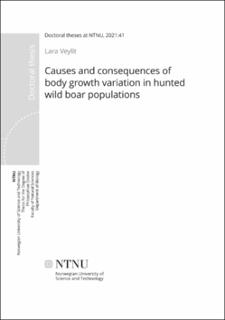| dc.contributor.advisor | Sæther, Bernt Erik | |
| dc.contributor.advisor | Gamelon, Marlène | |
| dc.contributor.author | Veylit, Lara | |
| dc.date.accessioned | 2021-02-17T07:28:27Z | |
| dc.date.available | 2021-02-17T07:28:27Z | |
| dc.date.issued | 2021 | |
| dc.identifier.isbn | 978-82-326-5434-5 | |
| dc.identifier.issn | 2703-8084 | |
| dc.identifier.uri | https://hdl.handle.net/11250/2728560 | |
| dc.description.abstract | The life of an organism can be simply described as its survival, growth, reproduction, and death. These life-history traits are influenced by both natural environmental variation as well as human activity (i.e. global climatic change, hunting). While survival and reproduction are well-studied traits within the field of ecology, causes of body growth variation and its consequences for the dynamics of populations (e.g. growth or decline in population size) is relatively poorly understood. Body growth is relatively understudied due to the rarity of long-term studies with multiple measures of individuals throughout life, a requirement for studying body growth.
In this thesis, I investigated causes and consequences of body growth variation in multiple European populations of hunted wild boar populations. Not only was I able to address fundamental questions related to body growth within the field of ecology using these data, but inform management of a species of critical concern. Indeed, the rapid increase in the abundance of wild boar throughout Europe poses an economic threat. Wild boar are both a reservoir of diseases (including African Swine Fever, an emerging infectious disease in Europe) and account for substantial economic losses in the form of crop destruction.
From the results of this thesis, I found faster body growth in wild boar under environmental conditions predicted to become more frequent under global climatic change. Further, a strong hunting pressure may be linked to faster body growth in early-life and more rapid development in wild boar. Faster body growth was linked to faster population growth rates in some study populations as well as faster population turnover. Thus, the results of this thesis may be useful to consider for managers seeking to predict how wild boar populations will change as an emblematic game species under the backdrop of climate change. | en_US |
| dc.language.iso | eng | en_US |
| dc.publisher | NTNU | en_US |
| dc.relation.ispartofseries | Doctoral theses at NTNU;2021:41 | |
| dc.relation.haspart | Paper 1: Veylit, Lara; Sæther, Bernt-Erik; Gaillard, Jean Michel; Baubet, Eric; Gamelon, Marlène. How do conditions at birth influence early‐life growth rates in wild boar?. Ecosphere 2020 ;Volum 11.(7)
https://doi.org/10.1002/ecs2.3167
This is an open access article under the terms of the Creative Commons Attribution License CC BY | en_US |
| dc.relation.haspart | Paper 2: Veylit, Lara; Sæther, Bernt-Erik; Gaillard, Jean-Michel; Baubet, Eric; Gamelon, Marlène. Grow fast at no cost: no evidence for a mortality cost for fast early-life growth in a hunted wild boar population. Oecologia 2020 ;Volum 192. s. 999-1012
https://doi.org/10.1007/s00442-020-04633-9
This is an open access article under the terms of the Creative Commons Attribution License CC BY | en_US |
| dc.relation.haspart | Paper 3: Veylit, L., Sæther, B.-E., Gaillard, J.-M., Baubet, E., Gamelon, M. Evidence for context-, sex- and cohort-specific lifetime growth in a wild mammal. | en_US |
| dc.relation.haspart | Paper 4: Gamelon M., Touzot, L., Baubet E., Cachelou, J., Focardi S., Franzetti B., Nivois E., Veylit L., and Sæther B.E. Effects of pulsed resources on the dynamics of seed consumer populations: a comparative demographic study in wild boar. In press, Ecosphere.
This is an open access article under the terms of the Creative Commons Attribution License
CC BY | en_US |
| dc.title | Causes and consequences of body growth variation in hunted wild boar populations | en_US |
| dc.type | Doctoral thesis | en_US |

